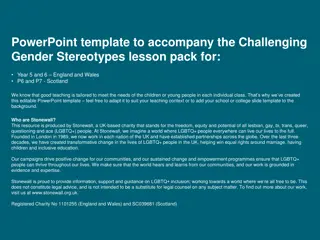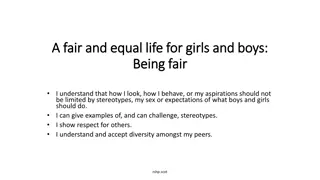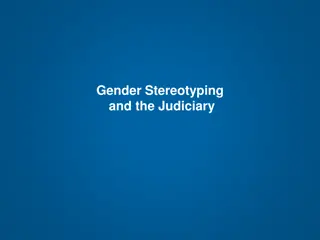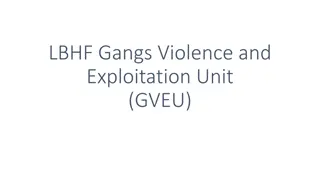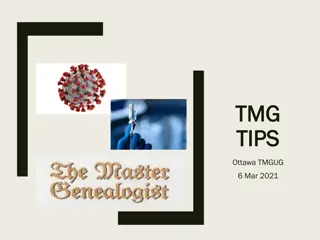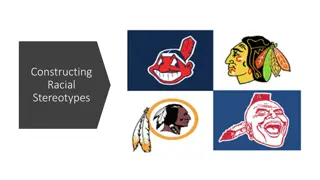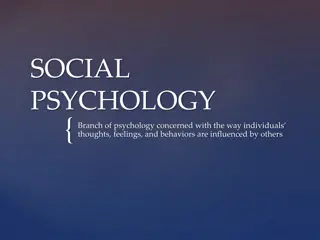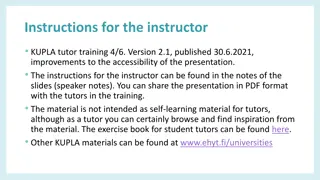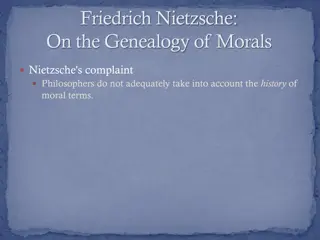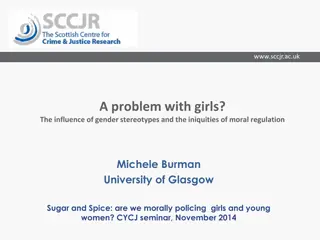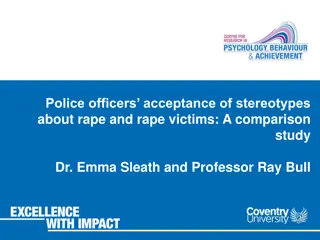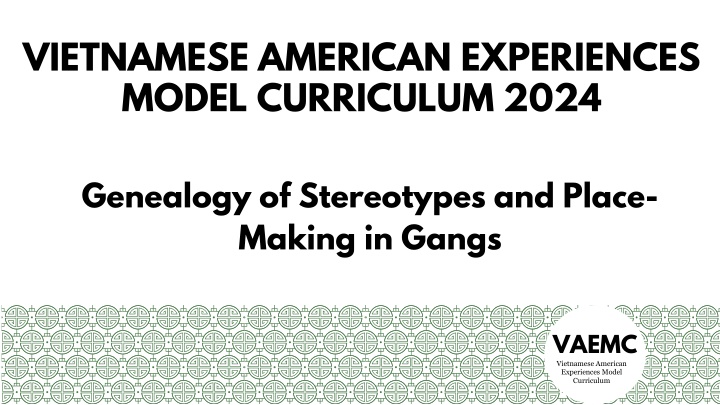
Vietnamese American Experiences: Navigating Stereotypes and Gang Dynamics
This curriculum delves into the genealogy of stereotypes and place-making in Vietnamese American communities, particularly focusing on the sociohistorical context of gang involvement and the challenges faced by refugees in adapting to life in America. It explores the intersection of socioeconomic factors, sociocultural contexts, and racial discrimination experienced by Vietnamese Americans, shedding light on the collective strategies adopted for survival, with a case study based in Eastside San Jose.
Download Presentation

Please find below an Image/Link to download the presentation.
The content on the website is provided AS IS for your information and personal use only. It may not be sold, licensed, or shared on other websites without obtaining consent from the author. If you encounter any issues during the download, it is possible that the publisher has removed the file from their server.
You are allowed to download the files provided on this website for personal or commercial use, subject to the condition that they are used lawfully. All files are the property of their respective owners.
The content on the website is provided AS IS for your information and personal use only. It may not be sold, licensed, or shared on other websites without obtaining consent from the author.
E N D
Presentation Transcript
VIETNAMESE AMERICAN EXPERIENCES MODEL CURRICULUM 2024 Genealogy of Stereotypes and Place- Making in Gangs VAEMC Vietnamese American Experiences Model Curriculum
Cultural Energizer This is an introductory music video that demonstrates the Viet OG aesthetic and characteristics. Identify which aspects of the music video most resonate with their own understanding of Vietnamese Americans. What about this music video strikes you as particularly Vietnamese American ?
Sociohistorical Context Overlapping histories of the War on Crime and arrival of the 2nd and 3rd waves of refugees from Vietnam (1980 s and beyond) Historical Context 1983: Reagan organizes the President's Commission on Organized Crime. 1984: meeting about Asian gangs (Chinese/ Japanese/ Vietnamese) 1991: Senate Hearing that pinpoints fear of Southeast Asian refugee gangs. At a separate Senate hearing in 1986, national anxieties over Asian gangs prompted Congress to begin thinking about how to use immigration law as a way to complement criminal law, fearing that it had become too easy for undesirables to become U.S. citizens. Chinese and Vietnamese crime members are often naturalized U.S. citizens, and we may need to look at the immigration laws to determine if we need to bolster them in order to deport those few among them engaged in violent crime. (from Lisa Marie Cacho's Social Death)
Experiences of Being Shaped by Ones Environment Socioeconomic context behind their arrival and resettlement (in the hood) Sociocultural contexts Relationships with refugee parents and academic expectations Social/cultural capital (of parents and children) and adaptation to American society while maintaining ethnic community Cultural difference in values b/t 1.5/2nd gen youth and their parents re: academic achievement, dependence on children as cultural brokers/translators (Flipped sense of authority & familial roles)
Experiences of Being Shaped by Ones Environment Sociocultural contexts (continued) Racialization, Racial discrimination/prejudice experienced in ghettos/hyperghettos Gang involvement as a means to collectively address racial slurs and (micro)aggressions experienced by refugee newcomers in adolescence Collective strategy influenced by necessity to survive (survival mentality/mindset) Case study: Eastside San Jose and embeddedness in multiracial community influenced by racially diverse, working-class, lower-income neighborhoods
Relationship to Racialized Places and Spaces in Little Saigon Survival Mentality Considering the racial and ethnic makeup of low-income and violent communities that host bad refugees The early 2000s Import Model and Hyphy makeup trends used by Asian Americans to appear tough and arguably differentiate them from their Asian international counterparts continue with the contemporary generation of ABGs or Asian Baby Gangsters / Asian Baby Girls.
Relationship to Racialized Places and Spaces in Little Saigon The Hyphy movement started in the San Francisco Bay Area in the late 1990s when the late Mac Dre spearheaded a style of Bay Area hip-hop music and dance that continued through the early 2000s by way of other rappers of color who wanted young kids our age finding something positive to represent where we re from (Horowitz 2016; BillyJam 2008). The movement garnered a specific Bay Area style that included sporting streetwear, filled-in high arched eyebrows, and large hoop earrings. Today s Asian Baby Girl wears false eyelashes, contoured face makeup, ombre-dyed blonde hair, and low-cut, cleavage-baring attire. San Jos ABG s express both a look and the lifestyle which largely includes raving at EDM festivals, drinking boba at Pekoe, and vaping. (Trazo)
Personal Narrative Review the following sources to explore and gather inspiration. Choose at least 3 sources and narratives to explore to provide a variety of context and models for your own personal stories. Mainstream and Independent Representations of Vietnamese American Original Gangsters (OGs) from the early 2000 s: 1. In the mainstream - Clip of Johnny from Dust of Life (2006) o https://www.youtube.com/watch?v=ckHlU8x5Zmc o Clip of Johnny from The Fast and the Furious (2001) o https://www.youtube.com/watch?v=6hxOoM0-NJI 2. In the undercurrents (subculture/emergent culture) o lMusic Video: "Vietnamese Gang" by Thai VG ft Khanh Nho (https://www.youtube.com/watch?v=CTWt0pxAgiw)
Sources (Continued) 3. Short History of ABG Aesthetic o It was a cultural reset: a short history of the ABG aesthetic o https://i-d.vice.com/en/article/g5p44x/it-was-a-cultural-reset-a-short-history-of-the-abg-aesthetic o What the ABG identity says about ESEA femininity o https://www.michigandaily.com/michigan-in-color/what-the-abg-identity-says-about-ese-femininity/ 4. Kevin Nguyens Lifestyle o https://www.bigstrawmagazine.com/home/hwbo7fods0wglfs9tjbd201d0zqapo) 5. Northern California: Eastside San Jose (Let s get hyphy the hyphy movement) (see Exclusive Interview with Rap Artist Thai of 454 Life for more information: o https://www.youtube.com/watch?v=zrg2jPEjJSY) 6. Southern California: Orange County, Westminster, Garden Grove (Let s race/ride import cars and models) (See "Locked Up Vietnamese California" Interview with Tin Nguyen o https://boomcalifornia.org/2018/04/11/locked-up-vietnamese-california/)
Source Notes Source Name/Author/Origin/Identity/Background What Vietnamese American stereotypes were prevalent in the story or subject s experiences? Social cultural origins and prevalence of these stereotypes in society How did this impact (positive and negative) their identity and life experiences? How were the experiences of Vietnamese American youth in the 1.5 and 2nd generation shaped by gang culture and how did youth negotiate their racialized identities and sense of belonging against systemic oppression? Theme or lesson takeaway from subjects experiences Aha! Moments or connections that can be made to student s personal life and experiences
Cultural Production Taking the lessons learned from the stories of Vietnamese American OGs from the past that you ve been introduced to, consider the circumstances and factors that have influenced your own sense of belonging (or exclusion) in a community or society. Assume and reflect upon your role as a future OG in your own right: what lessons from your life would you want to pass on (or khuy n, in Vietnamese) to the next generation? What identity pieces do you possess that have been influenced by societal, cultural, environmental factors? Express this in a personal narrative, free flowing spoken word piece, song or rap.

